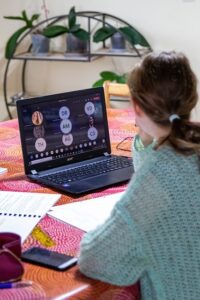Vital Signs of Life
Temperature, Pulse, Respiration and Blood Pressure. These four vital signs provide clues about the status of an individual’s physical condition. Long ago, doctors figured out that the vital signs of a healthy person do not change very much and that each vital sign has a normal range.
For example, we all know that the temperature of the human body should be about 98.6 degrees F. So, if by taking a temperature, and the reading is 103.4 degrees F, you know that something is wrong. You must call for immediate medical attention! Likewise, someone’s health is probably in serious trouble if their temperature is only 94.2 degrees F.
During school or orientation, you learned the four simple procedures for checking vital signs. Learning these procedures was pretty easy, right? They are painless and can be done in just a few minutes using basic, inexpensive equipment.
You have probably had lots or regular practice taking vital signs. And that’s good! It is important to practice even simple procedures like taking someone’s pulse or counting respirations.
Occasionally, it is also good to review what you know about vital signs.
Remember…by checking vital signs sometimes, you may catch a change in someone’s condition – before it gets serious.
Temperature


What is Body Temperature?
For the human body to function, it needs to stay warm. This body heat stays stable and is measured as a person’s temperature. It is normal for a person’s temperature to fluctuate up and down depending on the time of day and what the person is doing
Types of Thermometer
Glass: Thermometers made of glass contain a silver-colored substance called Mercury. It takes at least three minutes for the mercury inside the thermometer to read a person’s temperature
Digital: These are inexpensive and are commonly used. They are operated by a switch of a button and show a person’s temperature in less than 60 seconds.
Taking a Temperature
What You Need:
- A clean thermometer
- Disposable, plastic thermometer covers, if applicable.
Step-By-Step Instructions:
- Prepare the thermometer. If you are using a glass thermometer, be sure to shake it down until it reads 950F or less. If you are using a digital thermometer, be sure to turn it on.
- Position the thermometer. In the case of an oral temperature, insert the thermometer under the tongue, slightly to the side. Do not hold or bite the thermometer with your teeth. It is best to keep the thermometer steady.
- Wait. Remember the glass thermometers take at least three minutes to register an accurate temperature.
- Digital and electronic. These are battery-operated and are often quite expensive. They register temperature within a few seconds. Some use a probe that is put under the tongue, and some are placed gently in the ear. You will hear “a beep” when they are finished measuring the temperature.
- Read the thermometer. Carefully remove the thermometer (along with the plastic cover) from the mouth. Remove the plastic cover – without touching the part that has been in the mouth – and discard. Hold the thermometer at eye level. Turn a glass thermometer until you see the solid silver line of mercury. The point at which the mercury stops, marks the temperature. Reading a digital thermometer is easier. You simply take the numbers on display.
Related: Ways To Recognize Normal Body Temperature, Pulse, Respiration and Blood Pressure
| Time For a Laugh! Doctor: “Did you take the patient’s temperature?” Nurse: “No! Is it missing?” |
Pulse
What is Pulse?
- Every time the heart beats, it sends a rush of blood into the arteries. Each of these “rushes” can be felt as a pulse. The number of times a heart beats per minute is called the pulse rate.
- The pulse can be felt at many different points on the body, but for vital signs, the pulse is usually taken by feeling the radial artery – the radius that runs between the elbow and the thumb side-side of the body.
Taking a Pulse
What You Need:
- A watch or clock with a second hand.


Step-By-Step Instructions:
- Sit or stand facing the person.
- Feel for the pulse. Hold the person’s bare wrist in a comfortable position. Try resting it on a surface such as a bed or table. Feel for the pulse just above the person’s thumb and wrist.
- NOTE: Never use your thumb when taking pulses. (Your thumb has a pulse of its own and you may confuse your pulse with the other person). Instead, always use your first two or three fingers to feel the radial artery. Be sure to press gently.
- Check your watch or a nearby clock – make sure it has second hand. Watch the second hand and do not start counting until it reaches an easy starting point. For example, when the second hand reaches the 12 on your watch, start counting. Then you will know to stop counting when the second hand reaches the 6.
- A general rule of thumb is that a person’s pulse is higher after exercise and lower when the person is resting. Stress, illness, and medication can also affect a person’s pulse rate.
- Count. Typically, you can count a pulse for 30 seconds…and then multiply that number by 2. For example, say you count for 30 seconds and come up with the number 40. When you multiply this number by 2, you get a pulse of 80. This means that the heart rate is beating 80 times per minute.
- Pay careful attention to the rhythm of the pulse. Note if it sounds regular or irregular
Respiration
What is Respiration?
- The process of breathing in and out is called respiration. The number of breaths a person takes each minute is called the respiratory rate.
- One rise and fall of the chest counts as one breath. You can count breaths by watching someone’s chest go up and down or by feeling the movement with your hand.
- Respiratory rate can be affected by exercise, fever, medications, illness, and stress.
Counting Respiration
What You Need:
- A watch or nearby clock with a second hand.
Step-By-Step Instructions:


- NOTE: Count respirations as soon as you have finished counting the pulse – still using the wrist.
- Avoid staring at the chest while counting breaths. Instead, watch the chest rise and fall by looking at it out of the corner of your eye. A person may likely become self-conscious watching his or her breaths counted and breathe differently than normal.
- If you prefer not to watch the chest rise and fall, there are a couple of things you can try. First, try watching the nostrils to see if you can tell when a breath starts and stops. Otherwise, try placing your hand gently on the person’s chest so that you can feel his or her breathing.
- COUNT: Keep in mind that one rise and fall of the chest is counted as one breath. Start your counting when the second hand reaches an easy mark and continue for 30 seconds. For example, start when the second hand reaches the 9 and stop when it reaches the 3.
- Multiply the number you got by 2. This gives you the number of breaths per minute. For example, if it took 8 breaths in 30 seconds, when you multiply 8 times by 2, the final respiratory rate is 16 breaths per minute.
| Here’s Another Laugh…. Cindy’s client, Mrs. Duncan, was elderly and hard of hearing. One of Cindy’s nursing orders was to listen to Mrs. Duncan’s breathing. To do so, she placed her stethoscope on Mrs. Duncan’s chest and said loudly, Big breaths!” Mrs. Duncan looked down at her chest and said sadly, “Yes, they used to be…” |
Blood Pressure
What is Blood Pressure?
- As blood is pumped through the body, it puts pressure against the walls of the arteries. When you check a blood pressure, you are measuring how forcefully the blood is pushing on the artery.
- During each beat of the heart, the heart muscle does two things – first it contracts and then it relaxes. When the heart contracts, it empties itself, forcing blood into the arteries. This is when blood pressure is the highest. When the heart relaxes, it is taking time to fill up with more blood. This is when the blood pressure is the lowest.
- Healthy people with normal blood pressure have thin, flexible arteries. It is easy for the heart to pump blood through their bodies.
- People with high blood pressure tend to have thick, coarse arteries. For example, people with heart disease may have a thick buildup of cholesterol inside the blood vessels. And, as people age, they often get “hardening of the arteries”. When the arteries are not healthy, it is harder for the heart to push blood – and the blood pressure increases!
- Regular blood pressure checks are the best way to find out if someone has high blood pressure. (Remember…a person with high blood pressure may be asymptomatic).
- So how does a blood pressure cuff work? When the cuff is placed on a person’s arm and pumped up, it flattens a large artery in the arm – temporarily stopping the blood flow. As the air in the cuff is released, the blood starts to flow again. This makes a sound that can be heard, and you can continue to hear these “swishing” sounds until the artery is released all the way.
- Out of all the four vital signs, it is most important to practice taking blood pressures – even if you have been checking blood pressures for years.
Taking a Blood Pressure
What You Need:
To measure your blood pressure at home, you can use either:
- Aneroid Monitor
- Digital Monitor
Step-By-Step Instructions:
- Before you check your blood pressure:
- Wait 30 minutes after eating, drinking, or using alcohol or tobacco products.
- Empty your bladder.
- Rest for 3 to 5 minutes without talking.
- Sit comfortably with your legs and ankles uncrossed and your back supported
- Elevate your left arm to the level of your heart and while in a sitting position, place it on a table or desk remaining still.
- Wrap the cuff around the upper part of your bare arm. Make sure the cuff fits properly. There should be enough room for you to slip one fingertip under the cuff.
How To Use an Aneroid Monitor


- Put the stethoscope earpiece side into your ears facing toward your eyes.
- Place the stethoscope disk on the inside of your elbow.
- To inflate the cuff, squeeze the rubber bulb and continue until the pointer on the dial reaches 30 to 40 points higher than your systolic reading. The systolic reading is the top number of blood pressure. Again, inflate the cuff at a rapid rate, instead of a slow pace. Inflating the cuff too slowly will give you a false read.
- Gradually loosen the valve on the unit and slowly let some of the air escape from the cuff. Deflate the cuff 2 to 3 millimeters per second. If you let out too much air, you will not be able to measure your blood pressure.
- As you let the air out of the cuff, you will begin to hear your heartbeat. Be sure to listen carefully for the first sound. Check the blood pressure reading by looking at the pointer on the gauge. This number is your systolic.
- Proceed to continue deflating the cuff and listen to your heart. You will hear your heartbeat stop at some interval. Check the reading on the gauge and this number is your diastolic pressure.
- Write down the numbers as follows: The systolic pressure goes in front of the diastolic pressure. For example, 120/80.
- If you must repeat the steps again, wait 2 to 3 minutes before starting.
How to use a digital monitor


- Turn the power on to start the unit.
- On the automatic models, the cuff will inflate by itself with a push of a button. On the manual models, you must inflate the cuff and you do this by squeezing the rubber bulb at a rapid rate.
- After the cuff inflates, the automatic device will slowly let air out.
- Look at the display screen to get your blood pressure reading. It will show your systolic and diastolic pressures. Write down the measurement in your record. The systolic pressure goes in front of the diastolic pressure. For example, 120/80.
- Press the exhaust button to release the air from the cuff.
- If you must repeat the process, wait 2 to 3 minutes before starting.









